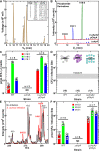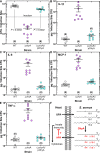Oleate Hydratase (OhyA) Is a Virulence Determinant in Staphylococcus aureus
- PMID: 34817231
- PMCID: PMC8612147
- DOI: 10.1128/Spectrum.01546-21
Oleate Hydratase (OhyA) Is a Virulence Determinant in Staphylococcus aureus
Abstract
Staphylococcus aureus is an important pathogen that relies on a variety of mechanisms to evade and counteract the immune system. We show that S. aureus uses oleate hydratase (OhyA) to convert host cis-9 unsaturated fatty acids to their 10-hydroxy derivatives in human serum and at the infection site in a mouse neutropenic thigh model. Wild-type and ΔohyA strains were equally infective in the neutropenic thigh model, but recovery of the ΔohyA strain was 2 orders of magnitude lower in the immunocompetent skin infection model. Despite the lower bacterial abundance at the infection site, the levels of interleukin 6 (IL-6), monocyte chemoattractant protein 1 (MCP-1), IL-1β, and tumor necrosis factor alpha (TNF-α) elicited by the ΔohyA strain were as robust as those of either the wild-type or the complemented strain, indicating that the immune system was more highly activated by the ΔohyA strain. Thus, OhyA functions to promote S. aureus virulence. IMPORTANCE The oleate hydratase protein family was discovered in commensal bacteria that utilize host unsaturated fatty acids as the substrates to produce a spectrum of hydroxylated products. These hydroxy fatty acids are thought to act as signaling molecules that suppress the inflammatory response to create a more tolerant environment for the microbiome. S. aureus is a significant human pathogen, and defining the mechanisms used to evade the immune response is critical to understanding pathogenesis. S. aureus expresses an OhyA that produces at least three 10-hydroxy fatty acids from host unsaturated fatty acids at the infection site, and an S. aureus strain lacking the ohyA gene has compromised virulence in an immunocompetent infection model. These data suggest that OhyA plays a role in immune modulation in S. aureus pathogenesis similar to that in commensal bacteria.
Keywords: Staphylococcus aureus; hydroxy fatty acids; oleate hydratase; soft tissue infection; unsaturated fatty acids; virulence; virulence determinants.
Conflict of interest statement
We declare no conflicts of interest and no competing financial interests.
Figures


References
-
- Ikeguchi S, Izumi Y, Kitamura N, Kishino S, Ogawa J, Akaike A, Kume T. 2018. Inhibitory effect of the gut microbial linoleic acid metabolites, 10-oxo-trans-11-octadecenoic acid and 10-hydroxy-cis-12-octadecenoic acid, on BV-2 microglial cell activation. J Pharmacol Sci 138:9–15. doi:10.1016/j.jphs.2018.06.015. - DOI - PubMed
-
- Miyamoto J, Mizukure T, Park SB, Kishino S, Kimura I, Hirano K, Bergamo P, Rossi M, Suzuki T, Arita M, Ogawa J, Tanabe S. 2015. A gut microbial metabolite of linoleic acid, 10-hydroxy-cis-12-octadecenoic acid, ameliorates intestinal epithelial barrier impairment partially via GPR40-MEK-ERK pathway. J Biol Chem 290:2902–2918. doi:10.1074/jbc.M114.610733. - DOI - PMC - PubMed
-
- Kaikiri H, Miyamoto J, Kawakami T, Park SB, Kitamura N, Kishino S, Yonejima Y, Hisa K, Watanabe J, Ogita T, Ogawa J, Tanabe S, Suzuki T. 2017. Supplemental feeding of a gut microbial metabolite of linoleic acid, 10-hydroxy-cis-12-octadecenoic acid, alleviates spontaneous atopic dermatitis and modulates intestinal microbiota in NC/nga mice. Int J Food Sci Nutr 68:941–951. doi:10.1080/09637486.2017.1318116. - DOI - PubMed
-
- Yang HE, Li Y, Nishimura A, Jheng HF, Yuliana A, Kitano-Ohue R, Nomura W, Takahashi N, Kim CS, Yu R, Kitamura N, Park SB, Kishino S, Ogawa J, Kawada T, Goto T. 2017. Synthesized enone fatty acids resembling metabolites from gut microbiota suppress macrophage-mediated inflammation in adipocytes. Mol Nutr Food Res 61:e17000641. doi:10.1002/mnfr.201700064. - DOI - PubMed
Publication types
MeSH terms
Substances
Grants and funding
LinkOut - more resources
Full Text Sources
Research Materials
Miscellaneous

